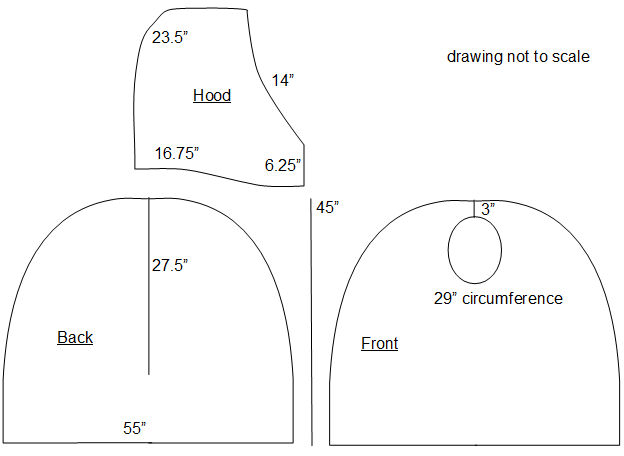Sewing - Poncho
All content copyright © 2010-2024 Frank Revelo, www.frankrevelo.com, United States copyright office registration number TX-7931345
Designed without arm holes, and thus more cape than poncho. Several problems with arm holes: allow lower part of arms to get wet; allow rain to blow in and wet torso, especially when poncho worn over a backpack; more cumbersome to put poncho on and take off when wearing backpack.
To keep back of poncho from blowing in wind, cord attached to back bottom hem runs through legs and attaches to belt of pants. To keep front of poncho from blowing in wind or interfering with hiking stick, simply grab hold of front bottom hem. Some people tie belt around waist to keep poncho from blowing in wind, but this interferes with ventilation and makes it more difficult to get in and out of poncho.
Poncho interferes with free use of hands, especially when leaning forwards. When rain reduced to light drizzle, possible to minimize interference by rolling up front and hooking into place using cord with mitten hook attached to inside front of hood. This also greatly increases ventilation.
Hood opening shifted forwards so that poncho longer in back than front, thus providing adequate coverage (just above knees) for man 5'11" (180cm) tall carrying medium-sized backpack. When worn without backpack, poncho reaches to just below knees.
Normally wear poncho with wide-brim hat, which provides sufficient protection from light rain that hood can be folded up (after snugging neck cord tight) to allow ventilation of neck area. In heavy rain or when cold, hold hood in place under wide-brim hat. Cord with mitten hook can be pulled through hood opening and attached to chinstrap of hat, to keep hat from blowing away in strong winds.
Can be difficult to put on poncho in windy conditions while wearing backpack. Hiking stick can be used to push back of poncho over backpack. Use handle of stick rather than sharp tip, of course.
Poncho can be hung from ridge of tarp, to protect from rain blowing in front of tarp.
Stuff sack sewed to inside back hood seam of poncho, so as to be always available.
Weighs about 215-250 grams when made of 1.6 oz/sqyd (1.9 oz/sqyd after coating) HyperD PU4000 from RipstopByTheRoll.com (215g for olive ponchos sewed in 2023, 250g for sage ponchos sewed in 2019). Shiny side is PU4000 coated, faces out, sealed with seam grip. Matte side is sil/PU and faces in.
Pattern:
Critical dimension where hood connects to front body. Hood pieces sewn together with 3/8" seam in back, and 1/2" flat-felled seam in front. Rear seam removes .75", front seam removes about 1.5", or 2.25" total. Hood thus about 30.75" circumference. Hood opening should be about 1.2" less than this, or about 29.5". Reasoning is that 3/8" seam between hood and body will expand hood opening by about 3/8" diameter, and circumference of circle (which hood opening approximates) expands by ratio of pi (3.14) times increase in diameter, or about 1.2". Making hood opening smaller than calculations imply allows for errors: hood will be too large, so just trim excess seam allowance on back of hood.

Materials:
- 3 yards waterproof fabric, at least 55" wide.
- 3 yards of 2mm dacron cord.
- Scrap of 3/4" nylon webbing.
- 2 small cordlocks.
- 2 mittenhooks.
- 100% polyester thread.
- 80/12 universal needles.
- Fray check.
- Appropriate seam sealer for fabric, brush for applying, optional corn starch.
Instructions:
- CUTTING: Cut 2 hood pieces (make mirror images of one another if material has front and back sides), and 1 each of front and back body pieces.
- HOOD: Sew hood pieces together at front using 1/2" flat-felled seam. Hood will be too large for opening, so pin bottom of hood to head opening, pin backs of hood pieces together, then trim from back as required. Sew bottom of hood to opening and back of hood together, both with 3/8" seam, zig-zag seam allowances. Sew buttonhole in front seam of hood and apply fray-check. Sew 3/8" tunnel around face opening of hood. Insert cord through tunnel and out buttonhole, with cordlock on end.
- BODY: Sew together front and back body pieces using 3/8" seam, zig-zag seam allowances. Sew 3/8" hem at bottom of poncho.
- LOOPS: Cut strip of fabric 1" wide, fold together and top-stitch to make strip 1/4" wide. Cut 3" strip, fold in half to make loop, sew to inside front neck seam allowance. Attach 15" length of cord to loop, with mitten hook on free end. Cut 2" of 3/4" wide webbing, sear ends to prevent fraying, fold and stitch to middle rear hem. Attach 40" of cord to this webbing loop, with mittenhook free end of cord. Cord can pulled between legs and then secured to pants belt, to prevent back of poncho from flying up in wind.
- STUFF SACK: Cut fabric 16" wide by 13" high, fold and stitch bottom and sides with 1/2" seam, zigzag seam to prevent fraying. Button hole near top of side seam. 1/2" tunnel at top. Insert cord through tunnel, with cordlock on end. Turn stuff sack inside out and stitch bottom seam allowance to inside back neck seam allowance of poncho.
- SEALING: Seal hood seams and shoulder seams of body. Seals on sides do not need to be sealed, since water will just roll down. Optionally put some corn starch on sealant to reduce tackiness.